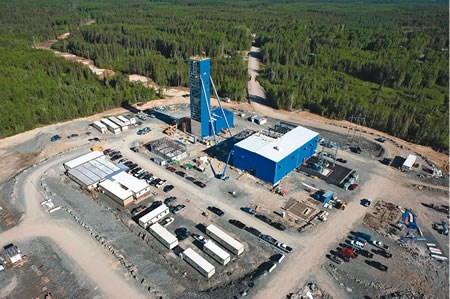Lake Shore Gold Corp., whose advanced exploration-stage Timmins Mine is located 18 kilometres west of the city, has signed an agreement to merg with West Timmins Mining Inc. worth $319 million.
The all-share transaction will create a combined company under the Lake Shore Gold name, and will assemble a 130-square-kilometre land package along the Timmins gold structure in the west end of the camp.
Current Lake Shore Gold shareholders will own 67 per cent of the new company, with the remaining 33 to be held by current West Timmins shareholders. Three of the 13 seats on the new, combined board of directors will go to West Timmins, whose shareholders will receive 0.73 of a Lake Shore Gold share for every West Timmins share.
"This combination of West Timmins Mining and Lake Shore Gold really creates the foundation for us to build the next great Canadian gold company," said Lake Shore Gold president and CEO Tony Makuch in a conference call with investors.
"With the extensive land package surrounding these assets, it gives us the ability to grow, to think now of mills, to think now of multiple mines, to think now of really doing some special things."
The heart of the deal lies with the Thunder Creek Joint Venture, located just 800 metres from Lake Shore Gold's flagship Timmins Mine.
Drill results from the property have returned such intersections as 24.6-grams-per tonne over seven metres, and 12.8-grams-per tonnes over 83.4 metres.
Its proximity will allow the site to make use of the Timmins Mine's environmental assessments as well as other baseline studies and resources, expediting production by three years.
Its location will also allow for advanced exploration work to drift from the Timmins Mine ramp at the 240-metre level and from the shaft at the 650-metre level.
Mineralization at Thunder Creek is expected to be reached by late 2010, when bulk sampling will begin. Once in use, Thunder Creek will be operated by management and crews from the Timmins Mine.
More than $6 million is to be spent on exploration this year alone.
"We look at Thunder Creek and the Timmins Mine as really being one deposit that is typical of the Timmins-type camp, with multiple ore bodies that create one big deposit, and one large-scale mine," said Makuch.
The Timmins Mine currently has reserves of 830,000 ounces, and a resource of 1.1-million ounces.
The extent of the potential production between the two sites could justify the construction of a new, dedicated mill for the two mines, rather than making use of Lake Shore Gold's fully-owned Bell Creek Mill, located 40 kilometres away.
Currently, the mill has a capacity of 1,500 tonnes per day, with the possibility of expanding to 3,000 tonnes per day.
The two companies have a combined 20 drills turning through the camp. Lake Shore Gold has $89 million in capital expenses budgeted through 2009, $14 million of which is for exploration. Although there have yet to be any estimates as to how much that would climb with the new company, officials say they will be pursuing "aggressive" work through the camp.
"Clearly, with the production potential at Timmins West and being able to Thunder Creek up and running ASAP, it's an outstanding opportunity," said Darin Wagner, president and CEO of West Timmins. "You're dealing with a camp here that is one of the great gold camps in the world, and a century of production leads to 70-million ounces, and now you become a very, very significant player in the camp with production coming from multiple mine complexes in the months ahead."
Two-thirds of West Timmins shareholders must approve the deal at a meeting to be held on Nov. 9, 2009, though Wagner said the result will likely be positive.




